Same Day Tours
SAME DAY DELHI TOUR
|
 |
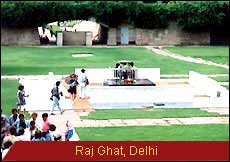
One of the most fascinating aspects of Delhi is the "visibility" of its historic past. Were it not for the demands of urbanization, large portions of the city could well be earmarked as archaeological parks. This is because the rulers of successive dynasties between the 13th and the 17th centuries established seven cities in different parts of Delhi. A chronological review of these cities fortunately also serves as a suitable itinerary for tourists and highlights the important monuments amongst the 1300 officially listed.
Delhi's history goes much further back in time than the 13th century. In 1955, excavations at the Purana Qila revealed that the site was inhabited 3000 years ago. Ware pottery known as Painted Gray Ware and dated to 1000 BC confirmed this as being yet another site associated with the epic Mahabharata. The excavations also cut through houses and streets of the Sultanate, Rajput, post-Gupta, Gupta, Saka-Kushan and Sunga periods, reaching down to the Mauryan era (300 BC), thus revealing almost continuous habitaion. The association of Emperor Ashoka (273-36 BC) with Delhi has come to light with the discovery of a Minor Rock Edict in the locality known as Srinivaspuri.
Travel-monitor is one of the best tour company that describes A clearer picture of the city emerges from the end of the 10th century, when the Tomar Rajputs established themselves in the in the Aravalli hills south of Delhi. The isolated, rocky outcrop facilitated the defence of the royal resort which the Rajputs called Dhilli or Dhillika. The core of the first of the seven cities was created by Anangpal Tomar who is said to have built Lal Kot, which is the first known regular defence work in Delhi. The Chauhan Rajputs later captured Delhi from the Tomars . Prithviraj III, also known as Rai Pithora, extended Lal Kot, adding massive ramparts and gates, and made Qila Rai Pithora the first city of Delhi.
Today, only the ramparts are visible near the Qutub Minar , though the city is known to have had several Hindu and Jain temples. Prithviraj was ruling Delhi when Muhammad of Ghur invaded India, and died fighting the invader at the Second Battle of Tarain in 1192. Ghur returned, but left as his viceroy, his slave Qutbuddin Aibak.
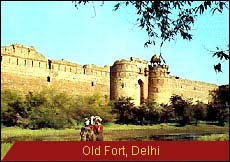
In 1206, Qutbuddin crowned himself as the Sultan of the Slave or Mamluk dynasty, and became the first Muslim ruler of Delhi. Qutbuddin, had however, commenced his architectural career even before he chose to become the sultan. The mosque was essential to the Islamic emphasis on congregational prayer, while the burial of the dead, as opposed to cremation, introduced the tomb to India.
The earliest of these Islamic structures are to be seen in the Qutub complex and the incorporation of many Hindu elements is due to the ready availability of building material and the use of local craftsmen. Qutbuddin raised the Quwwat-ul-Islam (might of Islam) mosque, which is the earliest extant mosque in India. Within its spacious courtyard he retained the 4th century Iron Pillar, probably the standard of an ancient Vishnu temple. The pillar has puzzled scientists, as its iron has not rusted in all these centuries.
In 1199, Qutbuddin raised the Qutub Minar either as a victory tower or as a minaret to the adjacent mosque. From a base of 14.32 mtrs it tapers to 2.75 mtrs at a height of 72.5 mtrs. It is still the highest stone tower in India, one of the finest tower Islamic structures ever raised and Delhi's recognized landmark. It was completed by the Sultan's successor and son-in-low, Iltutmish. The tomb of Iltutmish, which he himself built in 1235, is nearby. Its interiors are profusely decorated with calligraphy, thought the dome has collapsed.
The Khalji rulers displaced the Slave dynasty in 1290, and when Alauddin Khali ordered renovations of the mosque in 1311, he also raised the impressive Alai Darwaza, the southern entrance to the mosque. It is the first example of a building employing wholly Islamic principles of construction, including the true arch. In 1303, Alauddin, established the second city of Delhi, called Siri, of which nothing remains but the embattlements. He also had dug a vast reservoir, Hauz Khas, to sypply water to his city.
Contemporary historians has made
delhi tour operators as the
best tourist operators in India and describe the Delhi of that time as being the "envy of Baghdad, the rival of Cairo and the equal of Constantinople". (for
the sake of
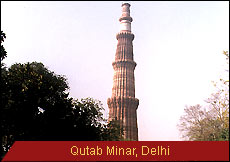
convenience,
tourists visiting the Qutb complex could also see the Tomb of AdhamKhan and
Zafar Mahal in Mehrauli, and the Tomb of Jamai-Kamali behind the Qutb Minar.
These, however, belong to a later date.) The Khalhjis were replaced by the Tughlaq dynasty in 1321. of its eleven rulers, only the first three were interested in architecture and each of them established a new city.
PLACES TO SEE
QUTUB MINAR
The origins of Qutab Minar are shrouded in controversy. This place is also included in Same day delhi tour .Some believe it was erected as a tower of victory to signify the beginning of the Muslim rule in India. Others say it served as a minaret to the muezzins to call the faithful to prayer. No one can, however, dispute that the tower is not only one of the finest monuments in India, but also in the world.
Qutab-ud-din Aibak, the first Muslim ruler of Delhi, commenced the construction of the Qutab Minar in 1200 AD, but could only finish the basement. His successor, Iltutmush, added three more storeys, and in 1368, Firoz Shah Tughlak constructed the fifth and the last storey. The development of architectural styles from Aibak to Tughlak are quite evident in the minar. The relief work and even the materials used for construction differ.
RED FORT
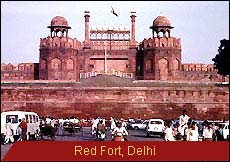 So called because of the red stone with which it is built, the Red Fort is one of the most magnificent palaces in the world. India's history is also closely linked with this fort. It was frorth here ht the British deposed the last Mughal ruler, Bhadur Shah Zafar, marking the end of the three century long Mughal rule. That’s why this place is included in the Budget tour packages from Delhi.It was also fromits ramparts that the first prime. Minister of India, pandit Jawharlal Nehru, announced to the nation that India was free form colonial rule.
So called because of the red stone with which it is built, the Red Fort is one of the most magnificent palaces in the world. India's history is also closely linked with this fort. It was frorth here ht the British deposed the last Mughal ruler, Bhadur Shah Zafar, marking the end of the three century long Mughal rule. That’s why this place is included in the Budget tour packages from Delhi.It was also fromits ramparts that the first prime. Minister of India, pandit Jawharlal Nehru, announced to the nation that India was free form colonial rule.
The mughal emperor, Shah Jahan, after ruling from Agra for eleven years, decided to shift to Delhi and laid the foundation stone of the Red Fort in 1618. For its inauguration in 1647, the main halls of the palace were draped in rich tapestry and covered with silk from china and velvet from Turkey. With a circumference of almost one and a half miles, the fort is an irregular octagon and has two entrances, the Lahore and Delhi Gates
HUMAYUN'S TOMB
The mughals brought with them a love for gardens, fountains and water. The first mature example of Mughal architecture in India, Humayun's Tomb was built by the emperor's grieving widow, Haji Begum, in 1565 AD. Constructed with red sandstone and ornamented marks the beginning of a new tradition of ornate style which culminated in the Taj Mahal of Agra and also the cheap tour in new delhi.
Designed by the Persian architect, Mirza Ghyas, Humayun's Tomb shows a marked shift from the Persian tradition of using coloured tiles for ornamentation. Located in the midst of a large square garden, screened by high walls, with gateways to the south and west, the tomb is a square tower surmounted by a magnificent marble dome. The dome stands 140 feet from the base of the terrace and is topped with a copper pinnacle.
JANTAR MANTAR
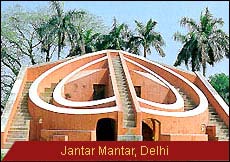
At first sight, the Jantar Mantar appears like a gallery of modern art. It is, however, an observatory. Sawai Jia Singh II of Jaipur (1699-1743), a keen astronomer and a noble in the Mughal court, was dissatisfied by the errors of brass and metal astronomical instruments.
Under patronage from the emperor, he set on himself the task of correcting the existing astronomical tables and updating the almanac with more reliable instruments. Delhi's Jantar Mantar is the first of the five observatories that he built with large masonary instruments.
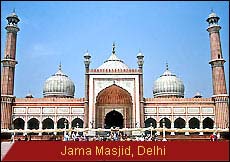 Work on the Jama Masjid mosque was begun in 1650 by the Mughal Emperor Shah Jahan to complement his palace at the Red Fort. More than 5,000 workers toiled for six years to complete the largest mosque in India. Every Friday, the emperor and his retinue would travel in state from the fort to the mosque to attend the congressional prayers.
Work on the Jama Masjid mosque was begun in 1650 by the Mughal Emperor Shah Jahan to complement his palace at the Red Fort. More than 5,000 workers toiled for six years to complete the largest mosque in India. Every Friday, the emperor and his retinue would travel in state from the fort to the mosque to attend the congressional prayers.
A fine example of Mughal architecture, the Jama Masjid has three gateways. The largest and highest on the east was reserve exclusively for the emperor. The main courtyard of the emperor. The main courtyard of the mosque is 408 square feet and paved with red stone. In the centre is a large marble tank in which the devout wash before attending prayers
INDIA GATE
Built as a memorial to commemorate the 70,000 India soldiers killed in World War I, India Gate was designed by Sir Edwin Lutyens and completed in 1931. Located on Rajpath, the road which leads to the magnificent Rashtrapati Bhawan, the gate is 160 feet high with an arch of 138 feet. Built from sandstone, the arch also houses the Eternal Flame, a gesture in memory of the Indian soldiers who laid their lives in the 1971 war with Pakistan.
RAJGHAT
The mortal remains of Mahatma Gandhi were cremated on this spot on the west bank of the river Yamuna on the evening of January 31, 1948. A simple open platform inscribed with the Mahatma's last words, 'Hey Ram' (Oh God) is set in a garden with fountains and a variety of exotic trees.


 One of the most fascinating aspects of Delhi is the "visibility" of its historic past. Were it not for the demands of urbanization, large portions of the city could well be earmarked as archaeological parks. This is because the rulers of successive dynasties between the 13th and the 17th centuries established seven cities in different parts of Delhi. A chronological review of these cities fortunately also serves as a suitable itinerary for tourists and highlights the important monuments amongst the 1300 officially listed.
One of the most fascinating aspects of Delhi is the "visibility" of its historic past. Were it not for the demands of urbanization, large portions of the city could well be earmarked as archaeological parks. This is because the rulers of successive dynasties between the 13th and the 17th centuries established seven cities in different parts of Delhi. A chronological review of these cities fortunately also serves as a suitable itinerary for tourists and highlights the important monuments amongst the 1300 officially listed. In 1206, Qutbuddin crowned himself as the Sultan of the Slave or Mamluk dynasty, and became the first Muslim ruler of Delhi. Qutbuddin, had however, commenced his architectural career even before he chose to become the sultan. The mosque was essential to the Islamic emphasis on congregational prayer, while the burial of the dead, as opposed to cremation, introduced the tomb to India.
In 1206, Qutbuddin crowned himself as the Sultan of the Slave or Mamluk dynasty, and became the first Muslim ruler of Delhi. Qutbuddin, had however, commenced his architectural career even before he chose to become the sultan. The mosque was essential to the Islamic emphasis on congregational prayer, while the burial of the dead, as opposed to cremation, introduced the tomb to India.  convenience,
tourists visiting the Qutb complex could also see the Tomb of AdhamKhan and
Zafar Mahal in Mehrauli, and the Tomb of Jamai-Kamali behind the Qutb Minar.
These, however, belong to a later date.) The Khalhjis were replaced by the Tughlaq dynasty in 1321. of its eleven rulers, only the first three were interested in architecture and each of them established a new city.
convenience,
tourists visiting the Qutb complex could also see the Tomb of AdhamKhan and
Zafar Mahal in Mehrauli, and the Tomb of Jamai-Kamali behind the Qutb Minar.
These, however, belong to a later date.) The Khalhjis were replaced by the Tughlaq dynasty in 1321. of its eleven rulers, only the first three were interested in architecture and each of them established a new city. So called because of the red stone with which it is built, the Red Fort is one of the most magnificent palaces in the world. India's history is also closely linked with this fort. It was frorth here ht the British deposed the last Mughal ruler, Bhadur Shah Zafar, marking the end of the three century long Mughal rule. That’s why this place is included in the Budget tour packages from Delhi.It was also fromits ramparts that the first prime. Minister of India, pandit Jawharlal Nehru, announced to the nation that India was free form colonial rule.
So called because of the red stone with which it is built, the Red Fort is one of the most magnificent palaces in the world. India's history is also closely linked with this fort. It was frorth here ht the British deposed the last Mughal ruler, Bhadur Shah Zafar, marking the end of the three century long Mughal rule. That’s why this place is included in the Budget tour packages from Delhi.It was also fromits ramparts that the first prime. Minister of India, pandit Jawharlal Nehru, announced to the nation that India was free form colonial rule.
 Work on the Jama Masjid mosque was begun in 1650 by the Mughal Emperor Shah Jahan to complement his palace at the Red Fort. More than 5,000 workers toiled for six years to complete the largest mosque in India. Every Friday, the emperor and his retinue would travel in state from the fort to the mosque to attend the congressional prayers.
Work on the Jama Masjid mosque was begun in 1650 by the Mughal Emperor Shah Jahan to complement his palace at the Red Fort. More than 5,000 workers toiled for six years to complete the largest mosque in India. Every Friday, the emperor and his retinue would travel in state from the fort to the mosque to attend the congressional prayers.